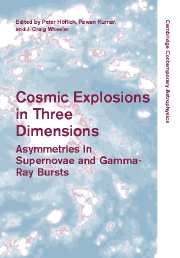Book contents
- Frontmatter
- Contents
- Part I Introduction
- Part II Supernovae: Observations Today
- Part III Theory of Thermonuclear Supernovae
- Part IV Theory of Core Collapse Supernovae
- Part V Magnetars, N-Stars, Pulsars
- Part VI Gamma-ray Bursts
- 36 GRB 021004 and Gamma-Ray Burst distances
- 37 Gamma-Ray Bursts as a laboratory for the study of Type Ic supernovae
- 38 The diversity of cosmic explosions: Gamma-Ray Bursts and Type Ib/c supernovae
- 39 A GRB simulation using 3-D relativistic hydrodynamics
- 40 The first direct Supernova/GRB connection: GRB 030329 / SN 2003dh
- 41 Gamma-Ray Burst environment and energetics
- Part VII Conference Summary
- References
36 - GRB 021004 and Gamma-Ray Burst distances
Published online by Cambridge University Press: 11 August 2009
- Frontmatter
- Contents
- Part I Introduction
- Part II Supernovae: Observations Today
- Part III Theory of Thermonuclear Supernovae
- Part IV Theory of Core Collapse Supernovae
- Part V Magnetars, N-Stars, Pulsars
- Part VI Gamma-ray Bursts
- 36 GRB 021004 and Gamma-Ray Burst distances
- 37 Gamma-Ray Bursts as a laboratory for the study of Type Ic supernovae
- 38 The diversity of cosmic explosions: Gamma-Ray Bursts and Type Ib/c supernovae
- 39 A GRB simulation using 3-D relativistic hydrodynamics
- 40 The first direct Supernova/GRB connection: GRB 030329 / SN 2003dh
- 41 Gamma-Ray Burst environment and energetics
- Part VII Conference Summary
- References
Summary
Abstract
This article will cover two topics at the intersection of Gamma-Ray Bursts and supernovae that have been much studied by the Texas group with relevance for the 3-D structure of core collapse explosions. The first topic is the high-velocity and high-excitation absorption lines seen in GRB 021004 (and other more recent events). These lines must come from (likely clumpy) shells around the progenitor star, and hence can provide a unique means of knowing the nature of the exploding star. In particular, the lines imply that normal GRBs form from the core collapse of a massive star, and thus that GRBs are closely related to supernovae. The second topic is the four luminosity indicators for Gamma-Ray Bursts and their implications for cosmology. The validity of the luminosity (and hence distance) indicators is already well demonstrated, although the current accuracy of the distances is roughly a factor of three times worse than for Type Ia supernovae. With GRBs serving as standard candles visible out to redshifts of >12 or farther, they can be used for many of the same purposes in cosmology now reserved for supernovae at low redshifts. With the launch of Swift in 2004, hundreds of bursts can then be used to construct Hubble diagrams to z ≥ 5, to measure the star formation rate to z ∼ 12 or farther, and to serve as beacons for discovering the Gunn-Peterson effect.
GRB/SN connections
Gamma-Ray Bursts (GRBs) and supernovae (SNe) have long been connected. Before the discovery of GRBs, S.
- Type
- Chapter
- Information
- Cosmic Explosions in Three DimensionsAsymmetries in Supernovae and Gamma-Ray Bursts, pp. 317 - 326Publisher: Cambridge University PressPrint publication year: 2004



